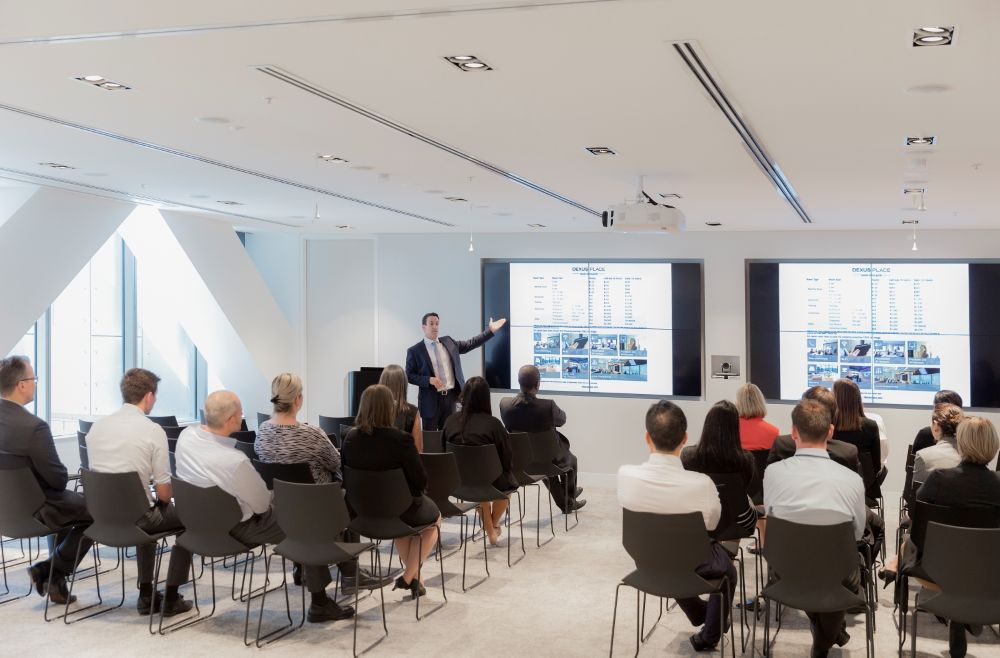The traditional office has changed. The modern work week is a fluid blend of in-office days and remote flexibility. This hybrid model offers teams greater freedom and balance, but it also presents a critical challenge: how do you maintain seamless productivity, strong team culture, and clear communication when your team is distributed?
The answer lies in equipping your team with the right digital collaboration technologies and grounding them in a physical environment built to amplify those tools. This guide explores the essential technologies every business needs to succeed in the hybrid era and how the right physical environment can turn everyday tools into a unified, high-performing ecosystem.
What is collaboration technology?
Collaboration technology refers to the digital tools and platforms that help teams communicate, plan, and create together, no matter where they are. These technologies connect remote and in-office employees seamlessly, bridging physical distance and ensuring projects move forward efficiently.
From instant messaging and video conferencing to shared workspaces and project management software, collaboration tools are the digital backbone of modern teamwork. They streamline communication, reduce friction, and enable real-time problem-solving. This helps businesses accelerate their digital transformation and build more connected, agile workplaces.
Beyond productivity, these technologies also play a key role in building a culture of trust in the workplace. By enabling transparency, accountability, and open communication, collaboration tools help teams feel more aligned and supported, regardless of where they work.
Whether your team works from a coworking space, home office, or client site, the right collaboration technology ensures everyone stays aligned, productive, and connected.
The digital toolkit part 1: Real-time communication hubs
The foundation of any successful hybrid team is effortless communication. This requires platforms that cater to both instant, synchronous chat and organised, asynchronous dialogue, eliminating information silos.
For instant connection: Slack & Microsoft Teams
Think of these platforms as your business’s digital headquarters. They’re the virtual equivalent of tapping a colleague on the shoulder or gathering for a quick chat.
- Slack offers a user-friendly interface and powerful app integrations, making it ideal for creative and agile teams.
- Microsoft Teams, meanwhile, provides deep integration with Microsoft 365, offering smooth collaboration across Outlook, SharePoint, and OneDrive.
Both platforms act as the central nervous system for hybrid work—keeping conversations organised and projects moving.
For organised dialogue: Twist & Basecamp
To reduce notification fatigue, tools like Twist and Basecamp take a slower, more thoughtful approach to collaboration. They use topic-based threads rather than fast-moving chats, helping teams maintain clarity and focus. These platforms are especially useful for teams spread across multiple time zones, ensuring no message or idea gets lost.
The digital toolkit part 2: Project management & productivity suites
In hybrid work, clarity is everything. Project management tools give teams a single source of truth, ensuring everyone knows their priorities, deadlines, and responsibilities.
Visualising workflow: Asana, Trello, & Monday.com
These tools turn complex projects into simple visual workflows. Using Kanban boards, timelines, and charts, teams can track every task from “To Do” to “Done.” Managers can instantly view progress and resource allocation, ensuring accountability and momentum across distributed teams.
Seamless co-creation: Google Workspace & Microsoft 365
The days of emailing attachments named "Final_Report_v3_updated.docx" are over. Cloud-based suites like Google Workspace and Microsoft 365 have become essential for hybrid collaboration. They enable multiple users to edit the same document, spreadsheet, or presentation simultaneously, removing version confusion and speeding up feedback loops. No more endless email threads; just smooth, real-time co-creation from anywhere.
The digital toolkit part 3: Virtual workspaces & immersive conferencing
How do you replicate the creative spark of an in-person brainstorming session when half the team is remote? The answer lies in tools designed to create an engaging and virtual collaborative workspace.
Face-to-face from anywhere: Zoom, Google Meet, & Teams
Video conferencing is now a cornerstone of work, but best-in-class platforms offer more than just a video feed. Advanced features like breakout rooms for smaller group discussions, interactive polls, and integrated chat functionalities help make virtual meetings more engaging and productive. These tools are no longer just for meetings; they are for training, workshops, and virtual team-building events.
The unlimited canvas: Miro & Mural
These digital whiteboard platforms are perhaps the most powerful virtual collaborative workspace solutions for creativity and strategy. They provide an infinite canvas where distributed teams can brainstorm with digital sticky notes, map out user journeys, build flowcharts, and run design thinking workshops in real-time. For a team that relies on visual collaboration, these tools are nothing short of revolutionary.
Key functions of collaboration technology
Collaboration technology is more than just communication software, it’s a complete ecosystem that supports connection, learning, coordination, and efficiency.
Communication and coordination
At its core, collaboration technology simplifies how teams communicate and stay organised. Instant messaging, video calls, and file-sharing capabilities create a virtual office where everyone can connect effortlessly.
Beyond conversations, these platforms help coordinate daily operations—scheduling meetings, tracking deadlines, and managing calendars—all from one place. This level of integration streamlines teamwork and reduces the back-and-forth that often slows projects down.
Learning and development
Modern collaboration tools also make employee growth easier. Features like video conferencing and asynchronous learning platforms allow for flexible, accessible training across time zones. Teams can participate in live workshops or access recorded sessions anytime. Shared digital libraries of documents and multimedia training materials ensure continuous learning and skill-building.
Streamlined project management
Keeping projects on track is simpler with collaboration tools. Built-in dashboards display tasks, progress, and deadlines, allowing managers to monitor workload distribution in real-time. This visibility supports better decision-making, reduces bottlenecks, and ensures accountability across every project stage.
Workspace booking and resource management
In today’s flexible workplace, not everyone needs a permanent desk. Collaboration platforms that integrate workspace booking functions make it easy for employees to reserve desks, meeting rooms, or creative studios through an app. This supports hybrid work arrangements and maximises space utilisation—an essential feature for businesses operating in coworking spaces or shared offices.
How The Work Project powers your business
The most advanced collaboration tools can only go so far without the right physical foundation. That’s where The Work Project Australia transforms how businesses operate.
Each location across Sydney, Melbourne, Brisbane, and Perth is designed to complement the technologies that drive hybrid work, creating a seamless blend of digital and physical productivity.
- Enterprise-grade connectivity: High-speed, secure networks ensure video calls, cloud platforms, and real-time collaboration apps run smoothly.
- Tech-enabled meeting rooms: Equipped with HD displays, video conferencing systems, and professional-grade audio to make hybrid meetings effortless.
- Flexible layouts and ergonomic design: A range of private offices, hot desk office spaces, and events rooms accommodate every working style. From focused individual tasks to collaborative team sessions and client presentations.
- Community-driven coworking spaces: As a leading coworking space in Australia, TWP fosters spontaneous connections and knowledge-sharing, adding the human element that digital tools alone can’t replicate.
At The Work Project, you’re not just renting a workspace, you’re empowering your team to work smarter, connect better, and grow faster.
Elevate your team with the perfect hybrid workspace

Success in the hybrid era isn’t just about adopting the latest collaboration tools, it’s about integrating them within a workspace that empowers your team to do their best work. By combining digital collaboration technologies with tech-enabled, flexible office spaces, businesses can create an environment where communication flows effortlessly, projects stay on track, and creativity thrives.
At The Work Project Australia, every location is designed to support both in-person and remote collaboration, with high-speed connectivity, fully equipped meeting rooms, and versatile workspaces that adapt to your team’s needs.
Ready to see how the right environment can unlock your team’s full potential? Book a tour at The Work Project today and experience hybrid collaboration at its best.






